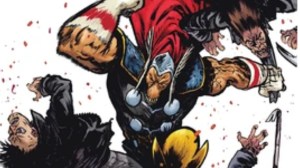The Dark Knight. The Caped Crusader. The World’s Greatest Detective. The Batman. Stalking the darkness of Gotham City on a self-appointed crusade against criminals in the corrupt city having witnessed the murder of his parents as a child, Batman is one of the most popular and most iconic characters in the world of comics. In the more than 80 years since his debut, the vigilante superhero has seen many incarnations on both page and screen and this week, the latest debuts with Matt Reeves’ The Batman. Portrayed by Robert Pattinson, the film is set to deliver a new take on this iconic and beloved character so ahead of the Dark Knight’s latest live-action appearance in The Batman, here’s what you need to know about Gotham’s protector.
Videos by ComicBook.com
Bruce Wayne/Batman debuted in Detective Comics #27 on March 30, 1939, in the story “The Case of the Chemical Syndicate”. Created by Bill Finger and Bob Kane, Batman was originally a very “pulp” character who had little remorse over his brutal treatment of criminals—including killing and the use of a gun. The character quickly became a huge hit and got his own solo book in 1940 while also appearing in Detective Comics. As Batman’s early appearances in Detective Comics continued, the character was fleshed out a bit more, including the introduction of some of the more iconic elements associated with the character to this day such as the batarang, a bat-themed vehicle, and the utility belt. It wasn’t until Detective Comics #33 in November 1939 that the most iconic aspect of Batman’s story was introduced, however. That issue gives Batman his origin story in which a young Bruce Wayne witnesses the murder of his parents, Thomas and Martha Wayne, at the hands of a mugger. The issue shows a still-grieving young Bruce just days later at his parents’ grave making the vow that sets the course of his life: “by the spirits of my parents [I will] avenge their deaths by spending the rest of my life warring on all criminals.”
While Batman started off as a hard, brutal vigilante swearing vengeance, the character did begin to soften a bit within a few years of introduction. Detective Comics #38 in 1940 saw the introduction of Batman’s first sidekick, Robin, and the first solo issue of Batman in 1940 also saw the character’s world get new challenges with the introduction of the Joker and Catwoman. Interestingly, this is also where the idea of Batman not killing and not using a gun comes from. It’s also in the early 1940s that the overall tone of Batman and DC Comics more broadly begins to shift further into something a bit more lighthearted due to World War II. The dark, menacing Batman becomes a more bright, colorful, paternal figure and as comics headed into the Silver Age, we begin to see Batman in more team-ups, particularly with Superman leading to World’s Finest Comics, a series that featured the two iconic characters and cemented their canonical friendship.
As the 1950s wore on, Batman stories continued to take on campier and lighter aspects and even veered into science fiction territory. Stories from the period saw Batman frequently dealing with elements such as space aliens, but also saw the “Bat Family” expanded with the introduction of characters like Batwoman in 1956 as well as Aunt Harriet, Ace the Bat-Hound and Bat-Mite. Batman also helped found the Justice League in 1960. But by the mid-1960s, Batman wasn’t in a good place in terms of financial success and popularity. Sales of Batman books had dropped dramatically and there were even plans to kill off the character. Instead, 1964 saw a huge shift in the character. Batman got a redesigned, more contemporary look—including the yellow ellipse behind the bat-insignia on his costume, his stories returned to their detective roots. The sci-fi elements were abandoned, but the 1960s also saw the rise of camp, thanks largely to the debut of the Batman television series starring Adam West. His light and campy “Bright Knight” take on Batman proved to be very popular with television audiences going so far as to spawn the first, full-length theatrical film adaptation of the character. The series was so popular it in turn boosted comic sales and heavily influenced the tone of the books. Unfortunately, the surge was short-lived. The television series was cancelled in 1968 and Batman comics soon fell out of favor once again.
With Batman’s popularity once again waning the character made a shift once again, beginning the trajectory towards the “dark and gritty” contemporary Batman best known to many readers. Dennis O’Neil and artist Neal Adams took on Batman in 1969 with a deliberate and specific effort to move Batman back to his roots beginning with Detective Comics #395. It wasn’t until 1986 that the full shift of Batman back to his roots would be complete, however. Frank Miller’s The Dark Knight Returns kicked off the Modern Age of Batman and also brought the character back, both in terms of popularity and as a financial success. In 1987, Miller’s “Year One” storyline redefined Batman’s character origin and recounts his first year as a crime-fighter. It’s this story that is a frequent source of inspiration when it comes to live-action takes on Batman and his origin. It’s this period of time that saw the next big live-action adaptation of Batman in Michael Keaton, who portrayed the vigilante in 1989’s Batman and 1992’s Batman Returns, both directed by Tim Burton. 1989’s Batman was particularly influenced, in term of tone and themes, by Miller’s The Dark Knight Returns as well as Alan Moore and Brian Bolland’s The Killing Joke and it was both Miller’s approach to the character and Keaton’s live-action performance that greatly cemented Batman’s popularity in the 1980s and beyond.
Generally, it’s the Batman Miller defines in “Year One” that carries through to contemporary comics, though there are many other notable storylines that have had huge impact on not just the character but fan perception of the character. Batman: Shaman followed the vein of “Year One” and not only fleshed out some of Bruce’s early training but brought an element of dark magic to some of the stories. This story in particular has been referenced by Pattinson as one of his inspirations for how he approached his take on the character for The Batman. The 1990s would see further explorations of this darker Batman. Chuck Dixon, Doug Moench, and Alan Grant introduced the villain Bane in 1993’s “Knightfall”, not only giving Batman another key villain but also leading to someone other than Bruce Wayne wearing the Batsuit for a time. The 1996 series The Long Halloween from Jeph Loeb and Tim Sale revisited Batman’s early career and saw the young vigilante pitted against his entire rogues gallery. Batman: Hush brought Batman and Catwoman together in a team up against his rogues while seeking out the identity of the mysterious Hush.
It was also the 1990s that offered up two additional, live-screen adaptations of Batman. Val Kilmer portrayed the hero in 1995’s Batman Forever and George Clooney suited up for Batman & Robin in 1997, though the latter drew more from the 1960s television series in terms of tone. More recently, Scott Snyder introduced the Court of Owls, a secret society that has controlled Gotham for centuries during his New 52 run, while Batman: Zero Year refined Batman’s origin again. This era saw another new live-action Batman as well, portrayed by Christian Bale in Christopher Nolan’s The Dark Knight Trilogy. Nolan’s films, though inspiration for those films came from storylines such as Year One, The Long Halloween, and The Man Who Falls. Bale’s Batman was followed by Ben Affleck who played the character in Zack Snyder’s Batman v Superman: Dawn of Justice in 2016 and again in Justice League the following year. Around that time, the DC Rebirth era of comics saw Batman take another shift. This time his relationship with Catwoman formalized and saw the pair engaged only for the wedding to ultimately not happen due to Bane’s machinations. In terms of live-action performances, the small-screen saw a few pop up during this time, with Iain Glen on HBO Max’s Titans, and as two very different versions of Bruce Wayne in The CW’s Arrowverse. The crossover event “Crisis on Infinite Earths saw legendary Batman voice Cator Kevin Conroy portray an old, alternative universe version of Batman while Batwoman gave us a glimpse of the Prime Earth’s Bruce Wayne as played by Warren Christie.
Given the character’s storied history and multitude of previous live action takes to build from, how The Batman and Pattinson will put their own stamp on the Dark Knight is anyone’s guess though one thing is clear: Gotham’s vigilante hero has always been rooted in darkness and it is from that darkness that Batman will continue to push Gotham towards the light.
The Batman will be released in theaters on March 4th.








![Simu Liu Confirms The 2 Dream X-Men Shang-Chi Works With On Avengers: Doomsday [Exclusive]](https://comicbook.com/wp-content/uploads/sites/4/2025/12/Simu-Liu-Avengers-Doomsday-interview.jpg?w=300)